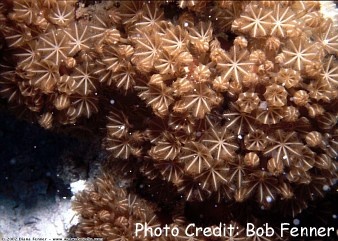
By Bob Goemans


These encrusting photosynthetic soft corals in the Family Xeniidae usually inhabit protected, fairly shallow nutrient rich back reef areas in the wild where gentle currents exist. Xenia polyps extend from its stalk or branches, while the larger Anthelia polyps arise directly from its encrusting base, a good way to tell these two favorites apart from each other.
As for those in the genus Xenia, their common names include Pulse Coral, Pom-Pom Xenia, Pumping Xenia, Red Sea Xenia, Blue Xenia, and Pulsing Xenia. Usually a mass of brown, long, yet thin stemmed flower-like eight tentacle polyps interconnected at the base with colors varying somewhat depending upon geographical location and position in the area of collection.
They can reach a height of about 6 inches (15 cm) or slightly more and are sometimes sensitive to nitrate-nitrogen levels over 5 mg/l. In fact, they may deteriorate if nitrate-nitrogen levels exceed 10 mg/l. Some species have polyps that pulse, opening and closing every one to five seconds. This may be a mechanism to rid excess oxygen, which can be highly toxic. Pulsing does not appear to be a feeding mechanism.
Some species appear slightly different in color, e.g., blue, green, or red. I attribute this to their ultraviolet (UV) protection pigments. Therefore, if you purchased "Blue" Xenia from the dealer, don't be surprised if the blue color dissipates after it has been in the aquarium for a few weeks. Xenia seems to do better under intense light. Those in this genus can spread like a carpet and can overgrow adjacent corals, however, they do not sting adjacent corals, simply overgrow them or shades them.
They are also thought to put out a chemical that interferes with the growth of mushroom corals. Yet some aquariums I've seen having both were all doing well. Yet, suggest Xenia be placed where water flowing past it will go directly to the filter system or sump, and not past mushroom colonies.
Also, Xenia seems to be prone to "crashes" where it dissipates rapidly. This can sometimes be stopped by increasing water flow, thinning out the colony, and/or increasing iodine level. The brown protozoan Helicostoma, a gelatinous slime-like material that is sometimes involved in Xenia crashes can occasionally be cleared up by bathing the specimen in a weak solution of Lugols iodine.
Those in the genus Anthelia inhabit protected, fairly shallow nutrient rich back reef areas, where gentle currents exist. It's tall, about 5 inches (12 cm), and its cylindrical-shaped polyps is part of an encrusting base that usually encompasses dead coral rubble and hardpan areas. Its polyps have eight delicate pinnate tentacles, which have been seen to rhythmically open and close (pulse) in the wild. The most common color is a rich brown, however, I've also seen ashen grey, and/or very light tan specimens. Common names include Waving Hand Coral, Feather Coral, Glove Coral and Pulse Coral.
Taking cuttings can propagate either of these corals and both are a fairly easy to maintain under the proper circumstances. There's also a small crab, usually found in pairs and visible only at night, that eats these soft corals. Usually found on top of closed heads at night. If possible, remove with tweezers.